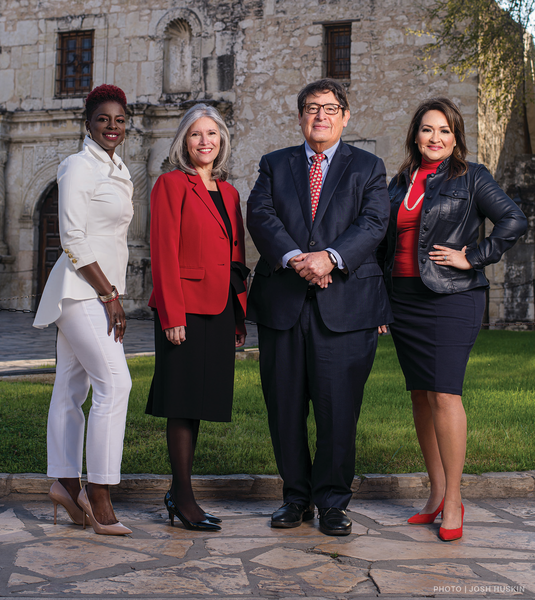TD Magazine Article
A Healthy Competition for Talent
University Health System makes the most of community partnerships, among other smart strategies for recruiting and retaining talent.
Mon Jul 20 2020

University Health System: 2020 BEST Award Winner, #16
10-Time Winner | Best of the BEST

University Health System makes the most of community partnerships, among other smart strategies for recruiting and retaining talent.
In San Antonio, Texas, one out of every six employees works in healthcare. The city is also home to many healthcare companies, all competing for patients—and, of course, employees.
At University Health System, the city's public health system, employees don't have to look far if they aren't satisfied in their current job; they could literally walk across the street and find another.
But UHS's stellar reputation for employee development helps keep employees from straying to the competition. The talent development team spearheads a variety of programs aimed at helping individuals grow their careers at the organization, from recently arrived immigrants who speak no English to highly credentialed physicians. The range of development opportunities include English as a Second Language courses, mobile learning, carefully curated learning pathways, leadership academies, scholarship opportunities at partner colleges and universities, and a generous tuition reimbursement fund.
All the offerings are part of a holistic learning culture for UHS's 8,500 staff members, says Denise Pruett, executive director of the Center for Learning Excellence. The talent development team especially relies on partnerships with local colleges, universities, and nonprofits to provide training to high-potential employees looking to change their careers—and their lives.
Helping employees double or triple their salaries
Perhaps one of the most meaningful talent development programs at UHS comes from its long-term partnership with a local nonprofit called Project QUEST. The nonprofit offers specialized training to prepare individuals for in-demand, living-wage jobs. UHS employees—including food service techs, medical assistants, and administrative assistants—have taken advantage of the training QUEST offers, upskilling into new roles such as registered nurses, radiography technicians, medical billing and coding staff, full stack software developers, systems administrators, and respiratory therapy technicians, among others.
The talent development team recently worked with the nonprofit to create a tailored, grant-funded training program for certified professional coders, a role for which UHS typically found challenging to recruit and retain.
Program applicants had to meet stringent criteria. They were vetted through their supervisors and then referred to QUEST to be screened for eligibility for grant funding. Eight candidates successfully completed the six-month program, which was held on-site at UHS. The qualified coders can now code 2,500 more accounts per week, which enabled the health system to replace its former vendors, saving the company an estimated $10,000 per month.
UHS is now working with QUEST to upskill another 36 employees, who are carefully assessed through an internal process at the nonprofit, in roles such as nursing and IT. Pruett says participation in the program will double or triple their wages—a truly life-changing result.
Boosting engagement by reducing leaders' training time
When training leads to such positive results for some employees, it can be hard to remember that—if not done well—it can be a burden for others.
UHS knew it could do more to make its training more accessible and less demanding for senior leaders, who are often pressed for time and dealing with multiple high-priority tasks at once. Its monthly instructor-led training for leaders could be expensive and logistically difficult to execute in a fast-paced, rapidly growing health system with numerous physical locations. So, the team augmented it with a mobile learning platform called Know on the Go, which provides bite-size lessons on leadership development for executives who find it difficult to attend in-person classes due to time and location challenges.
Via Know on the Go, leaders receive links to three- to four-minute microlearning videos, which they can view when it's most convenient for them. After each video, users receive three follow-up messages. The first is a short survey asking leaders to gauge their current level of acumen on the video's topic, as well as a list of additional resources. The next is a simple inspirational message that reinforces the video's content, and the last is another short survey designed to gauge leaders' retention of the subject matter.
Leaders are putting their learning to work, Pruett says. She reports that Know on the Go contributed to the significant boost in overall engagement that occurred after the tool deployed. UHS saw its highest-ever employee engagement scores in 2019, with 42 percent of employees scoring the company at 9 or 10 (10 is the highest) on being a great place to work.
"Our leaders' biggest challenge is time, and their attention is divided amongst patient experience, operational efficiency, employee engagement, and change management," Pruett explains. "Know on the Go assisted our employee engagement scores as it delivered leadership best practices in a fresh way."
Giving employees a path to success
For the past decade, the talent development team has been working on turning the many training and career development opportunities in its portfolio into learning pathways tailored for every discipline and every career level.
The pathways carve out rewarding career paths for employees by preparing them for promotions and increased pay at regular intervals. Many of the learning pathways include opportunities for participating employees to reinforce their learning by giving back as mentors and coaches to those coming along behind them on the path.
The talent development team continuously reviews and updates the pathways so that the components stay relevant, working with HR and various community partners—including the local workforce board and community system—to do so. The education development coordinator, who is part of the talent development team, advises individuals and groups (medical coders, for example) on career opportunities and their requirements and corresponding learning resources, both internal and external.
"The pathways create a trifecta," says Pruett. "Employees have a career path that leads to personal and professional growth, our organization has employees who are loyal, and our patients benefit from engaged employees who will provide high-quality, compassionate care. Investing in our employees keeps us strong and agile in a fast-changing healthcare environment."
View the entire list of 2020 BEST Award winners.

